SEOs are, more often than not, “cat people”. That’s no surprise, given that we spend a lot of time online, and given that The Internet Is Made Of Cats. That’s why the first website which I’m looking at in this series belongs to the Cats Protection charity – a UK organization dedicated to feline welfare.
I’m going to explore their website and see where they have issues, errors, and opportunities with their technical SEO. Hopefully, I’ll find some things which they can fix and improve, and thus improve their organic visibility. Maybe we’ll learn something along the way, too.
Not a cat person? Don’t worry! I’ll be choosing a different charity in each post. Let me know who you think I should audit next time in the comments!
Introducing the brandCats Protection (formally the Cats Protection League, or CPL) describe themselves as the UK’s Largest Feline Welfare Charity. They have over 250 volunteer-run branches, 29 adoption centers, and 3 homing centers. That’s a lot of cats, a lot of people, and a lot of logistics.
Their website (at https://www.cats.org.uk/) reflects this complexity – it’s broad, deep, and covers everything from adoption to veterinary servers, to advice and location listings.
Perhaps because of that complexity, it suffers from a number of issues, which hinder its performance. Let’s investigate, and try to understand what’s going on.
Understanding the opportunityBefore I dive into some of the technical challenges, we should spend some time assessing the current performance of the site. This will help us spot areas which are underperforming, and help us to identify areas which might have issues. We’ll also get a feeling for how much they could grow if they fix those issues.

The ‘Visibility Index’ score (Sistrix) for cats.org.uk, desktop and mobile
I’m using Sistrix to see data on the ‘visibility index‘ for cats.org.uk, for desktop and mobile devices. We can see that the site experienced gradual growth from 2010 until late 2013, but – other than a brief spike in late-2018 (which coincides with Google’s “Medic” update in August)- seems to have stagnated.
Where they’re winningAs we dig into some of the visibility data, you can see that Cats Protection rank very well in the UK for a variety of cat- and adoption-related phrases. Let’s see some examples of where they’re winning.
| Keyword | # | Page |
|---|---|---|
| lost cat | 1 | /help-and-advice/lost-a-cat |
| cats adoption | 1 | /adopt-a-cat |
| buying a cat | 1 | /adopt-a-cat/adopt-from-us |
| cat reproduction | 1 | /help/reproduction |
| cat charity | 1 | / |
| cat protection | 1 | / |
| cat neutering | 1 | /what-we-do/neutering |
| neuter cat | 1 | /what-we-do/neutering |
| buy a cat | 1 | /adopt-a-cat/adopt-from-us |
| cat help | 1 | /cat-care/help-and-advice |
| adopting a cat | 1 | /adopt-a-cat/ready-to-adopt |
| cat org | 1 | / |
| outdoor cats | 1 | /uploads/outdoor_cats.pdf |
| heart murmur in cats | 1 | /uploads/heart_disease.pdf |
| free cat neutering | 1 | /what-we-do/neutering |
| cats | 2 | / |
| cat care | 2 | /cat-care |
| feral cats | 2 | /help-and-advice/feral-cat |
| cat for adoption | 2 | /adopt-a-cat |
| cats for adoption | 2 | /adopt-a-cat |
| cat body language | 2 | /help/body-language |
| plants poisonous to cats | 2 | /help/dangerous-plants |
| neutering cats | 2 | /what-we-do/neutering |
| found cat | 2 | /help-and-advice/found-a-cat |
| old cats | 2 | /help-and-advice/elderly-cats |
| cat behaviour problems | 2 | /behaviour-problems |
They’re doing a great job. They’re ranking highly for important, competitive keywords. In almost all cases, the result is a well-aligned page which is a great result, full of useful information.
SALE: Learn keyword research right!
- Find your most effective keywords
- Expert advice from SEO pro's at Yoast
- Online & on-demand SEO training
- Hands-on: start optimizing today!
These kinds of keywords likely account for a large proportion of the visits they receive from search engines. It’s reasonable to assume that they also drive many of their conversions and successful outcomes.
But they’re losing to the competitionIt’s not all good news, though. Once you explore beyond the keywords where they’re winning, you can see that they’re often beaten to the top positions on key terms (e.g., “adopt a cat”, where they rank #2).
In cases like this, they’re frequently outranked by one of three main competitors in the search results:
- Purina – a cat food manufacturer/retailer.
- Blue Cross – a charity dedicated to helping sick, injured and homeless animals
- The RSPCA – a general animal welfare and rehoming charity
Now, I don’t want to suggest or imply that any one of these is a better or worse charity, service, or result than Cats Protection. Obviously, each of these (and many more) charities and websites can co-exist in the same space, and do good work. There’s plenty of opportunity for all of them to make the world a better place without directly competing with each other.
In fact, for many of the keywords they’re likely to be interested in, the results from each site are equally good. Each of these sites is doing great work in educating, supporting, and charitable activity.
Even Purina, which isn’t a charity, has a website full of high quality, useful, content around cat care.
However, among the major players in this space, Cats Protection has the lowest visibility. Their visibility is dwarfed by Blue Cross and the RSPCA, and the gap looks set to continue to widen. Even Purina’s content appears to be eating directly into Cats Protection market share.
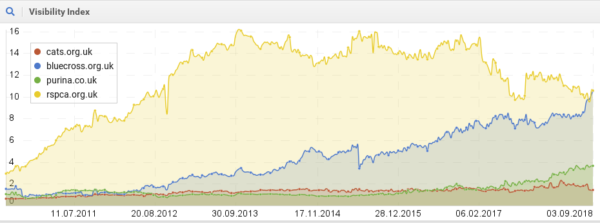
The Visibility Index of Cats Protection vs organic search competitors over time
It’d be a shame if Cats Protection could be helping more cats, but fail to do so because their visibility is hindered by technical issues with their website.
To compete, and to grow, Cats Protection needs to identify opportunities to improve their SEO.
Looking at the long tailCats Protection probably doesn’t want to go head-to-head with the RSPCA (or just fight to take market share directly from other charities). That’s why I’ll need to look deeper or elsewhere for opportunities to improve performance and grow visibility.
If the site gets stronger technically, then it’s likely to perform better. Not just against the big players for competitive ‘head’ keywords, but also for long-tail keywords, where they can beat poorer quality resources from other sites.
As soon as you start looking at keywords where Cats Protection has a presence but low visibility, it’s obvious that there are many opportunities to improve performance. Unfortunately, there are some significant architectural and technical challenges which might be holding them back.
I’ve used Sitebulb to crawl the site, and I’ve found three critical issues. These areas contribute significantly to the low (and declining) visibility.
Critical issues 1. The site is fragmentedEvery individual branch of the charity appears to get and maintain its own subdomain and own version of the website.
For example, the Glasgow branch maintains what appears to be a close copy of the main website, and both the North London branch and the Birmingham branch both maintain their own divergent ‘local’ versions of the site. Much of the content on these sites is a direct copy of that which is available on the main website.
Fragmentation is harming their performanceThis approach significantly limits visibility and potential, as it dilutes the value of each site. In particular;
- Search engines usually consider subdomains to be separate websites. It’s usually better to have one big site than to have lots of small websites. With lots of small sites, you risk value and visibility being split between each ‘sub site’.
- Content is repeated, duplicated, and diluted; pages that one team produces will often end up competing with pages created by other teams, rather than competing with other websites.
- The site doesn’t use canonical URL tags to indicate the ‘main version’ of a given page to search engines. This makes this page-vs-page competition even worse.
This combination of technical and editorial fragmentation means that they’re spread too thin. None of the individual sites, or their pages, are strong enough to compete against larger websites. That means they get fewer visits, less engagement, and fewer links.
You can see some examples below where fragmentation is a huge issue for search engines. Google – in its confusion between the multiple sites and duplicate pages – continually switches the rankings and ranking pages for competitive terms between different versions. This weakens the performance and visibility of these pages, and the overall site(s).
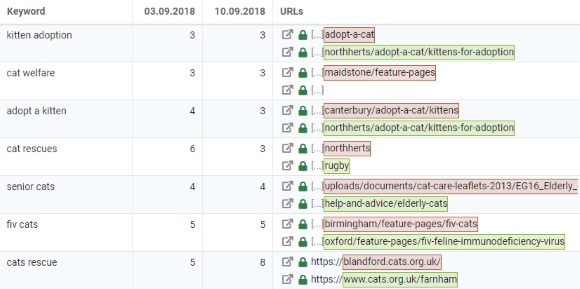
Google continually switches the ranking page(s) for competitive keywords
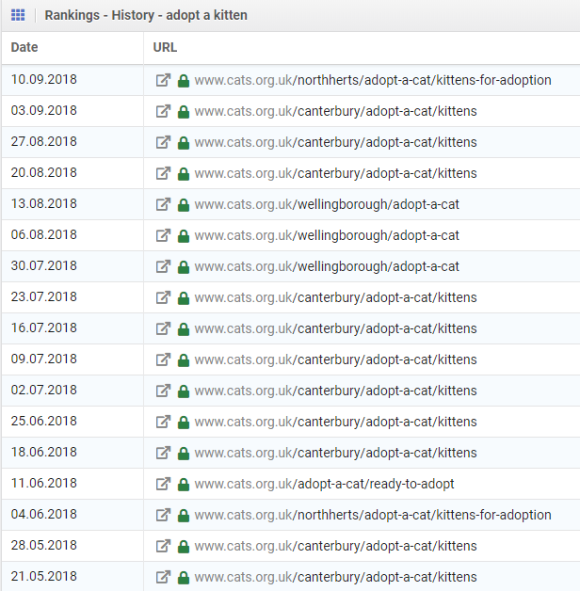
Rankings for “adopt a kitten” continually fluctuate between competing pages
If Cats Protection consolidated their efforts and their content, they might have a chance. Otherwise, other brands will continue to outperform them with fewer, but stronger pages.
Managing local vs general contentWhile it makes sense to enable (and encourage) local branches to produce content which is specifically designed for local audiences, there are better ways to do this.
They could achieve the same level of autonomy and localization by just using subfolders for each branch. Those branches could create locale-specific content within those page trees. ‘Core’ content could remain a shared, centralized asset, without the need to duplicate pages in each section.
At the moment, their site and server configuration actually appears to be set up to allow for a subdomain-based approach. https://birmingham.cats.org.uk/, for example, appears to resolve to the same content as https://www.cats.org.uk/birmingham. It seems that they’ve just neglected to choose which version they want to make the canonical, and/or to redirect the other version.
They’ve also got some additional nasty issues where:
- The non-HTTPS version of many of the subdomains resolves without redirecting to the secure version. That’s going to be fragmenting their page value even further.
- Requests to any subdomain resolve to the main site; e.g., https://ift.tt/2plqOOh returns the homepage. Aside from further compounding their fragmentation issues, this opens them up to some nasty negative SEO attack vectors.
- There are frequent HTTPS/security problems when local branches link (or are linked to) including the ‘www’ component and the location subdomain (e.g., https://www.vuildford.cats.org.uk/learn/e-learning-ufo).
Incidentally, if Cats Protection were running on WordPress (they’re on a proprietary CMS running on ASP.NET), they’d be a perfect fit for WordPress multisite. They’d be able to manage their ‘main’ site while allowing teams from each branch to produce their own content in neat, organized, local subfolders. They could also manage access, permissions, and how shared content should behave. And of course, the Yoast SEO plugin would take care of canonical tags, duplication, and consolidation.
Canonical URL tags to the rescueWhile resolving all of these fragmentation issues feels like a big technical challenge, there might be an easy win for Cats Protection. If they add support for canonical tags, they could tell Google to consolidate the links and value on shared pages back to the original. That way each local site can contribute to the whole, while maintaining its own dedicated pages and information.
That’s not a perfect solution, but it’d go some way to arresting the brand’s declining visibility. Regardless of their approach to site structure, they should prioritize adding support and functionality for canonical URL tags. That way they can ensure that they aren’t leaking value between duplicate and multiple versions of pages. That would also allow them to pool resources on improving the performance of key, shared content.
Even better SEO with Yoast SEO Premium!
- Optimize your site for the right keywords
- Never a dead link in your site again
- Previews for Twitter and Facebook
- Get suggestions for links as you write
The great news is, because they’re running Google Tag Manager, they could insert canonical URL tags without having to spend development resources. They could just define triggers and tags through GTM, and populate the canonical tags via JavaScript. This isn’t best practice, but it’s a lot better than nothing!
2. Their best content is buried in PDFsIn many of the cases where Cats Protection is outranked by other charities or results, it’s because some of its best content is buried in PDF files like this one.
PDFs typically perform poorly in search results. That’s because they can be harder for search engines to digest, and provide a comparatively poor user experience when clicked from search results. That means that they’re less likely to be linked to, cited or shared. This seriously limits the site’s potential to rank for competitive keywords.
As an example, this excellent resource on cat behavior currently ranks in position #5, behind Purina (whose content is, in my personal opinion, not even nearly as good or polished), and behind several generic content pages.
The information in here is deeper, more specific, and better written than many of the resources which outrank it. But its performance is limited by its format.
If this were a page (and was as well-structured and well-presented as the PDF), it would undoubtedly create better engagement and interaction. That would drive the kinds of links and shares which could lead to significantly increased visibility. It would also benefit from being part of a networked hub of pages, linking to and being linked from related content.
https://ift.tt/2xp93Ce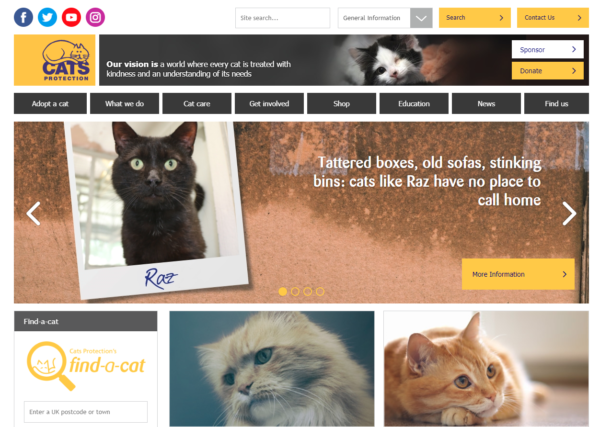
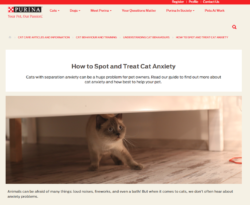
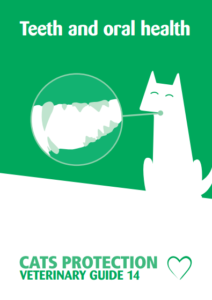
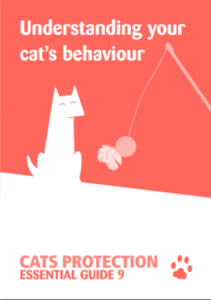
No comments:
Post a Comment